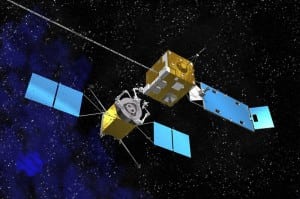In-Orbit Services Experts See Bright Future, Challenges

Artists rendering of a servicing spacecraft, left, approaching satellite needing assistance. Photo: NASA/Goddard Space Flight Center
[Via Satellite 09-03-2015] “Ten years from now we’ll have three legacy satellites refueled in orbit — past tense,” predicted Benjamin Reed, deputy project manager of the Satellite Servicing Capabilities Office at the NASA Goddard Space Flight Center during the American Institute of Aeronautics and Astronautics (AIAA) Space 2015 conference.
During the conference’s “On-Orbit Servicing Horizons” panel, Reed also predicted there would be two commercial ventures vying for future business from satellite customers on the same 10-year timeline. His comments were only met with contention from Craig Weston, CEO and president of ViviSat, who expected there would be even more than two companies set up to provide commercial in-orbit services within the next decade.
“I think the floodgates [for in-orbit servicing] are going to open, and I think that will be good for space and that will be good for industry,” said Weston. “Competition in ideas, competition in technologies, [and] competition in price.”
The Sept. 1 panel brought together a mix of experts from government — the United States Defense Advanced Research Projects Agency (DARPA) and NASA — and industry — Lockheed Martin, ViviSat, and MDA Robotics & Automation — to discuss the progress, challenges and future of in-orbit servicing capabilities. Panel participants aired similar predictions for the future of in-orbit services and how it will likely extend mission life for spacecraft through both in-orbit fueling and a range of other capabilities.
“As Lockheed sees these things, 10 years from now you can see an on-orbit serviced cryocooler. You can see us charging something like that and extending life of mission there,” said David Markham, vice president of advanced programs at Lockheed Martin Space Systems, demonstrating one of the many alternatives to in-orbit fueling that can help extend the life of legacy satellites.
Markham also foresaw that the ability to direct and tug satellites through in-orbit services will extend mission concepts for Geostationary Orbit (GEO) satellites, which will no longer be conceived of as “tethered mammals in the war-fight in space.”
Beyond GEO, Reed also forecasted that, going into the next decade, all Medium Earth Orbit (MEO) and Low Earth Orbit (LEO) satellites will be made capable of accepting servicing. “That doesn’t mean each one of them equally so, but it’s easy to make your satellite from not designed for servicing at all to serviceable. It is very low impact to do so,” Reed said.
All panelists agreed that in-orbit services are well on their way to becoming a critical part of space infrastructure, both in the near and long term, particularly, according to Dan King, director of business development for MDA Robotics and Automation, when it comes to changing the current satellite model from launch and replace to “launch, maintain and service.” To reach the optimistic threshold in the next decade, however, the panelists admitted there were several challenges — technical, cultural and regulatory — that industry and government alike have yet to tackle.
“Something that I think we’re going to need to come to grips with as [in-orbit servicing] takes off is standardization,” said Weston. “We probably need to agree on some standards and so we’ll need to think about ‘is that something that government dictates or is that something that industry and the government get together and sort through on their own?’”
Technical autonomy also poses an issue to successful robotic on-orbit servicing, says NASA’s Reed. Complete autonomy would be a large change from the in-orbit servicing that currently takes place on the International Space Station (ISS), the most salient current example of in-orbit servicing, in which man and machine work together to repair and maintain the inhabited research platform. “Since the Gemini days we’ve been rendezvousing two spacecraft in orbit, so no one is going to argue that bringing two spacecraft together is new; it’s been done for quite a few decades. But to do it autonomously, no human in the loop, especially with one side being non-cooperative, that is a world’s first, and that, we are still tackling,” he said.
While government and industry are sprinting toward applying in-orbit services in the next few years, Lockheed’s Markham admitted that navigating the business case and where in-orbit services can see the most utility or profitability may prove the most challenging obstacle.
“[The challenge] is now connecting the servicing philosophy in the concept of operations as you fly and sustain constellations. Identifying grappling points and handling points and management points is not all that difficult, and managing [Recovery Point Objective] RPO concepts and docking and assembly concepts is not all that difficult. The art of it is in where those practices offer utility and when and where and how do they want to be employed for effect. Where do our client operators want to use those for effect?” Markham asked, noting that commercial clients may want to use the services for differing concepts and, even within a company, may want to maintain separate satellites in a constellation in varying ways.
“We understand designs, we understand where to work with it, but more importantly, we want to understand where, when and how to use the utility for it,” he concluded.